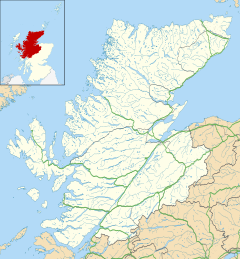Ardross, Highland
Ardross
|
|
|---|---|
| Ardross shown within the Highland council area | |
| Population | 150 (est.) |
| OS grid reference | NH6174 |
| Council area | |
| Lieutenancy area | |
| Country | Scotland |
| Sovereign state | United Kingdom |
| Post town | Alness |
| Postcode district | IV17 |
| Dialling code | 01349 |
| Police | Scottish |
| Fire | Scottish |
| Ambulance | Scottish |
| EU Parliament | Scotland |
| UK Parliament | |
| Scottish Parliament | |
Ardross (Scottish Gaelic: Àird Rois, high-point of [Easter] Ross) is a rural area in the Highland region of Scotland, 30 miles (48 km) north of the nearest city, Inverness. Ardross lies 10 miles (16 km) inland from the east-coast town of Alness and progressively becomes more mountainous to the west and north.
The area is populated by a small rural community mainly confined to the more fertile lower slopes to the east and the glacial glens of Strathrusdale and Strathy (Ardross). The total area comprises about 30 square miles (78 km2), most of which is lower slope farming, commercial pine forest on foothills and open mountain to the north and west. The largest concentration of dwellings are in the village of Dublin comprising about 30 houses and a church, so named as it was founded by Irish immigrant workers who built Ardross Castle.
The earliest inhabitants of Ardross were the Picts (6-10th century), and there are still recognisable remains of Pictish roundhouses at various locations in the area. The most notable surviving artefacts of their time in Ardross are two carved stone slabs depicting a wolf and a deer, some of the finest surviving Pictish animal symbols ever discovered, which are now displayed at Inverness Museum. The carvings were recovered from a drystone wall in Stittenham, Ardross in 1891. After the 10th century, habitation of the area became progressively more influenced by the Norse.
The Duke of Sutherland bought the 60,000-acre (240 km2) Ardross Estate in the late 18th century, and in 1845, sold it to Sir Alexander Matheson, 1st Baronet for £90,000.
Matheson improved the estate and placed it under the supervision of factor William MacKenzie, an engineer by profession. By 1875 the number of agricultural tenants had increased fivefold to over 500, with around 1,200 acres (4.9 km2) of arable land being improved. The architect Alexander Ross was commissioned to re-design Ardross Castle in the Scots Baronial style and following Sir Alexander's death, his son, Sir Kenneth Matheson, sold the estate in 1898 to Charles William Dyson Perrins, a Captain in the Highland Light Infantry, with interests in the Worcester Royal Porcelain Company and Lea & Perrins (Worcester) sauce. The estate was broken up and sold in 1937. Mr and Mrs Austin Mardon purchased Ardross Castle and 80 acres (320,000 m2) of associated land and lived there until 1983, when the castle and grounds were sold to the McTaggart family, who began a program of restoration work.
...
Wikipedia

